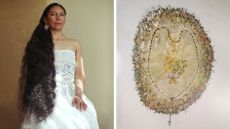Feminist art: a graphic history
A new graphic novel, The Women Who Changed Art Forever, by Valentina Grande and Eva Rosetti, tells the story of feminist art through four pioneers: Judy Chicago, Faith Ringgold, Ana Mendieta and the Guerrilla Girls

In 1971, American feminist art historian Linda Nochlin asked, ‘Why Have There Been No Great Women Artists’? The issue, she wrote in her essay, ‘lies not in our stars, our hormones, our menstrual cycles, or our empty internal spaces, but in our institutions and our education’. There had been great women artists, they had just been denied the opportunity of greatness.
A new graphic art book, The Women Who Changed Art Forever, tells the story of four trailblazers of feminist art: Judy Chicago, Faith Ringgold, Ana Mendieta and the Guerrilla Girls.

Beyond style, era or approach, feminist art was defined by a set of values, those which criticised sexist and racist institutions, strove for equality, and championed a revolution in the perception of women’s creativity.
Though it didn’t gain momentum until the mid-20th century, feminist art has its roots in the late 1900s and 1920s when women were offered the right to vote in the UK and America. As liberation began sweeping across the world, the first wave of feminist art was born. Women began asserting their position behind the canvas, instead of posing as objects of pleasure in front of it.

But during this time – with a few key exceptions, including Frida Kahlo – the majority of woman-made artwork did not portray ‘feminist’ themes, and many female artists struggled to ‘de-gender’ their work and find a seat at the male-dominated art table.
This all changed in the 1960s and 1970s with the second wave of feminist art. Progressive ideas emerged as society came to terms with a new ideology that placed value on the role of women in art. Instead of objects of the male gaze, women’s bodies could be tools to challenge the patriarchy.

Within the book – created by Valentina Grande and Eva Rosetti and published by Laurence King – each artist featured represents one of the four pillars of the movement. Judy Chicago – the artist behind The Dinner Party (1979), widely deemed the first epic feminist artwork – made us reassess the female body, sexuality and championed a new wave of female empowerment.
Wallpaper* Newsletter
Receive our daily digest of inspiration, escapism and design stories from around the world direct to your inbox.
Faith Ringgold, known for vibrant quilts confronting everyday racism, taught us that feminism should be universally accessible. Through performative works, Ana Mendieta used her body to confront violence against women, while anonymous art collective Guerrilla Girls continues to challenge male-dominated institutions through provocative, often public interventions.
The fight for equality is a long road and one that the world continues to navigate. The Women Who Changed Art Forever narrates this unfinished story with an accessible and vibrant approach, told through the art of four pioneers that tirelessly paved, and continue to pave, the way to a more equal art world.


INFORMATION
The Women Who Changed Art Forever: Feminist Art – The Graphic Novel, by Valentina Grande and Eva Rosetti, published by Laurence King, £14.99, hardback, available from 26 August 2021, laurenceking.com
Harriet Lloyd-Smith was the Arts Editor of Wallpaper*, responsible for the art pages across digital and print, including profiles, exhibition reviews, and contemporary art collaborations. She started at Wallpaper* in 2017 and has written for leading contemporary art publications, auction houses and arts charities, and lectured on review writing and art journalism. When she’s not writing about art, she’s making her own.
-
 Three new coffee makers for a contemporary brew, from a casual cup to a full-on branded espresso
Three new coffee makers for a contemporary brew, from a casual cup to a full-on branded espressoThree new coffee makers, from AeroPress, Jura and Porsche x La Marzocco, range from the defiantly manual to the bells and whistles of a traditional countertop espresso machine
By Jonathan Bell Published
-
 Don't miss Luxembourg's retro-futuristic lab pavilion in Venice
Don't miss Luxembourg's retro-futuristic lab pavilion in VeniceAs the Venice Biennale enters its last few weeks, catch 'A Comparative Dialogue Act' at the Luxembourg Pavilion
By Amah-Rose Abrams Published
-
 A Berlin park atop an office building offers a new model of urban landscaping
A Berlin park atop an office building offers a new model of urban landscapingA Berlin park and office space by Grüntuch Ernst Architeken offer a symbiotic relationship between urban design and green living materials
By Michael Webb Published
-
 ‘Gas Tank City’, a new monograph by Andrew Holmes, is a photorealist eye on the American West
‘Gas Tank City’, a new monograph by Andrew Holmes, is a photorealist eye on the American West‘Gas Tank City’ chronicles the artist’s journey across truck-stop America, creating meticulous drawings of fleeting moments
By Jonathan Bell Published
-
 'I’m So Happy You Are Here': discover the work of Japanese women photographers
'I’m So Happy You Are Here': discover the work of Japanese women photographersSubtitled ‘Japanese Women Photographers from the 1950s to Now’, this new monograph from Aperture is a fascinating insight into a critically overlooked body of work
By Jonathan Bell Published
-
 How the west won: Ivan McClellan is amplifying the intrepid beauty of Black cowboy culture
How the west won: Ivan McClellan is amplifying the intrepid beauty of Black cowboy cultureIn his new book, 'Eight Seconds: Black Cowboy Culture', Ivan McClellan draws us into the world of Black rodeo. Wallpaper* meets the photographer ahead of his Juneteenth Rodeo
By Tracy Kawalik Published
-
 ‘Package Holiday 1968-1985’: a very British love affair in pictures
‘Package Holiday 1968-1985’: a very British love affair in pictures‘Package Holiday’ recalls tans, table tennis and Technicolor in Trevor Clark’s wistful snaps of sun-seeking Brits
By Caragh McKay Published
-
 ‘Art Exposed’: Julian Spalding on everything that’s wrong with the art world
‘Art Exposed’: Julian Spalding on everything that’s wrong with the art worldIn ‘Art Exposed’, Julian Spalding draws on his 40 years in the art world – as a museum director, curator, and critic – for his series of essays
By Alfred Tong Published
-
 Marisol Mendez's ‘Madre’ unpicks the woven threads of Bolivian womanhood
Marisol Mendez's ‘Madre’ unpicks the woven threads of Bolivian womanhoodFrom ancestry to protest, how Marisol Mendez’s 'Madre' is rewriting the narrative of Bolivian womanhood
By Sofia de la Cruz Published
-
 Photo book explores the messy, magical mundanity of new motherhood
Photo book explores the messy, magical mundanity of new motherhood‘Sorry I Gave Birth I Disappeared But Now I’m Back’ by photographer Andi Galdi Vinko explores new motherhood in all its messy, beautiful reality
By Hannah Silver Published
-
 Best contemporary art books: a guide for 2024
Best contemporary art books: a guide for 2024From maverick memoirs to topical tomes, turn over a new leaf with the Wallpaper* arts desk’s pick of new releases and all-time favourite art books
By Hannah Silver Last updated